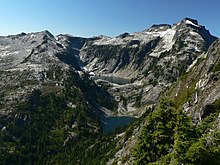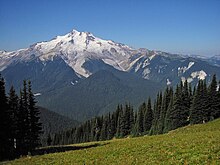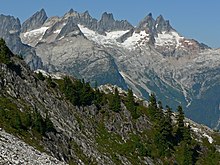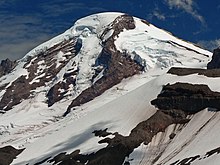Northern Cascade Range
| Northern Cascades, Canadian Cascades | |
|---|---|
|
Mount Shuksan , one of the most beautiful peaks in the North Cascades |
|
| Highest peak | Mount Baker ( 3286 m ) |
| location | Canada ( British Columbia ), USA ( Washington ) |
| part of | Cascade chain |
| Coordinates | 48 ° 56 ′ N , 121 ° 17 ′ W |
|
Location of the Northern Cascade Range in western North America |
|
The Northern Cascades (also North Cascades ) are part of the Cascade Range in western North America . They stretch on both sides of the border between the Canadian province of British Columbia and the US state of Washington and are officially known as the Cascade Mountains in the US and Canada . The part lying in Canada is for Americans the Canadian Cascades , a name that also includes the mountains above the eastern edge of the Fraser Canyon north to the city of Lytton at the confluence of the Thompson River and Fraser River .
They are predominantly non-volcanic, but contain the stratovolcanoes Mount Baker , Glacier Peak and Coquihalla Mountain , which are part of the volcanic arc of the Cascades .
geography
The US portion of the North Cascades and the neighboring Skagit Range in British Columbia are most notable for their dramatic scenery and the mountaineering challenges that arise from the steep and rugged terrain . While most of the peaks are below 3,000 m high , the lower valleys show a great relief and are often over 1,800 m high. The peaks of the Canadian part are not glaciated in the same way and comprise rocky "horns" that rise from plateau-like highlands. The Manning Provincial Park and the Cathedral Park are known areas with alpine meadows as American US also on the western flank of the part of the case. Portions of the U.S. side of the chain are protected as part of the North Cascades National Park .
The large amount of precipitation , much of it in the form of snow , and the resulting glaciation , combined with the tectonic uplift , create a dramatic landscape in the western part of the mountain range. Depth of glaciers in Pleistozän shaped trough valleys separating the scharfgradigen mountain ranges and peaks, which were formed of rezentem snow and ice to steep contours.
The eastern and northernmost parts of the mountain range are more like a plateau in character, but also, as in the case of the northernmost areas, are characterized by deeply dug valleys on the edge of the Fraser Canyon, namely that of the Anderson River .
expansion
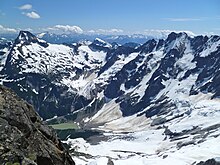
The Fraser River and the lowlands bordering its south bank form the northern and northwestern borders of the mountain range. To the east, the Okanogan Rivers and Columbia Rivers border the chain in the United States, while the northeastern border runs along the Thompson River over the Nicoamen Rivers , Lawless Creek, Tulameen Rivers, and Copper Creek to the Similkameen Rivers . To the west, the foothills of the Northern Cascades are separated from Puget Sound by a narrow coastal plain , except along Washington State Route 11 between Bellingham and Mount Vernon , where they directly reach the sound.
The southern limit of the North Cascades is less well defined. For this article, US Highway 2 is assumed as such, which runs over the Stevens Pass ; equivalent to this, the courses of the Skykomish River , Nason Creek and the lower Wenatchee River can be taken. This roughly follows Fred Beckey's geological classification in the Cascade Alpine Guide . and the definition from Peakbagger.com. Occasionally, the southern limit is determined by Snoqualmie Pass and the approximate route of Interstate 90 . The terms "North Cascades" or "northern cascades" are also used for the entire cascade chain north of the Columbia River .
Geologically, the North Cascades extend south to beyond Stevens Pass and west to the San Juan Islands . There is less agreement on the importance of the geological transitions to the Okanagan Highland in the east and to the Interior Plateau and the Coast Mountains in the north.
climate
The climate in the North Cascades varies enormously depending on the geographic location and altitude. The western slope of the chain is damp and cool with 1,500 ... 6,400 millimeters of annual precipitation. As a result, temperate rainforest grows in the lower valleys, which transforms into montane and alpine vegetation forms in the higher elevations on the mountain slopes and peaks . Summers are comparatively dry, with significantly less rainfall than in winter; Occasionally, warmer eastern and cooler western air masses meet over the cascades and create thunderstorms that can also move into the lower-lying cities. The eastern slope is in the rain shadow of the chain, so that wind and moisture are kept from the west and makes it significantly drier than the west; the climate becomes increasingly semi-arid down to the eastern lowlands . As in most mountains, rainfall increases dramatically with altitude. Ultimately, this leads to massive snowfalls and glaciation in the high-lying North Cascades.
Significant amounts of snow can fall on the eastern slopes and on the mountain passes. Cold Arctic air can flow south from British Columbia through the Okanogan River Valley into the bowl-like basin east of the Cascades. A phenomenon called cold air damming causes the arctic cold air to accumulate over the eastern slope of the cascades, particularly in the lower passes such as the Snoqualmie Pass and the Stevens Pass . The milder air masses influenced by the Pacific, which want to cross the cascades eastwards, are forced to rise by this "cold air dam". As a result, more snow often falls on the passes than in the higher elevations. This effect is only made possible by the relatively low-lying ski resorts on the Snoqualmie Pass (around 910 m) and on the Stevens Pass (around 1,200 m).
Partial chains
- North Cascades
- Skagit Range
- Chuckanut Mountains
- Entiat Mountains
- Chelan Mountains
- Methow Mountains (also called Sawtooth Ridge)
- Skagit River Group
- Canadian Cascades
- Skagit Range
- Hozameen Range
- Okanagan Range
- Coquihalla Range (name is unofficial)
- Llamoid Group (name is unofficial)
- Anderson River Group (name is unofficial)
geology
The main part of the North Cascades consists of “deformed , structurally complex pre- tertiary rock that has been changed by metamorphosis ”. This comes from different places around the globe: the region is made up of several (“maybe ten or more”) different terran of different ages and origins. These terranes are separated by a series of very ancient faults . The most important is the Straight Creek Fault, which runs north-south from Yale (British Columbia) via Hope , Marblemount down to Kachess Lake near the Snoqualmie Pass. There is evidence of notable past leaf displacement at this fault, which contains similar rocks separated by dozens of miles on either side of the fault. This is believed to be related to the northbound tectonic movement of the west coast relative to the rest of the continent.
For about 35 million years , the oceanic crust of the Pacific has been pushing below the continental margin , which has produced today's volcanoes and a series of igneous plutonites made of diorite and gabbro . The current uplift of the Cascade Range began about eight million years ago.

Rocks similar to those in the North Cascades can be found around the Mount Meager Massif in the Coast Mountains , where they border the Stikinia Terran of the Omineca-Intermontan Province, which dominates the Interior Plateau of British Columbia. This geological similarity between the North Cascades and Coast Mountains results in a fairly arbitrary boundary between the two.
In British Columbia, the western geological boundary of the North Cascades is defined by the Fraser River , which follows the Straight Creek Fault, while in the United States the western boundary is defined by the Puget Lowlands , although the San Juan Islands have significant expansions to the west of in rocks similar in origin to those found in the North Cascades.
The eastern geological boundary of the North Cascades can be marked by the Chewack-Pasayten Fault. This fault separates the easternmost part of the North Cascades, the Methow Terran, from the Quesnellia Terran, which is part of the Omineca and Intermontane Belts . The fault also separates the valley of the Methow River , part of the Methow Terran, from the Okanagan Range , part of the Quesnellia Terran. The Columbia River Basalt Group bounds the North Cascades to the southeast.
The southern limit of what is believed to be the "North Cascades" can be defined variously as the southern extension limit of the igneous and metamorphic terranes; it is generally north of Snoqualmie Pass, including the pass itself, or north of Naches Pass on the White River Fault Zone .
glacier
While alpine glaciers are a characteristic feature of the Cascades as a whole, this is especially true of the North Cascades. The stratovolcanoes (Mount Baker and Glacier Peak) are the most obviously glaciated peaks with the largest glaciers, but many of the smaller non-volcanic peaks are also glaciated. Between 1900 and 1950 all of these glaciers had retreated. From 1950 to 1975, many, but not all, glaciers expanded again. Since 1975, the retreat of all 107 glaciers observed since 1992 has accelerated. 2015 was a particularly devastating year for the Cascade Glaciers when an estimated five to ten percent mass loss was observed, the largest annual loss in over 50 years. There are an estimated 700 glaciers in the Northern Cascade Range, although some have now disappeared. The retreat of the glaciers is a serious threat to the water management of the region, as the glaciers (and the winter increase in snow) create a large reservoir of water. When the snow and ice melt in summer, the meltwater compensates for the seasonal decrease in rainfall. When the glaciers dwindle, less runoff is produced in the summer.
The cascades north of Snoqualmie Pass have 756 glaciers that cover an area of 270 square kilometers. For comparison, the entire Continental United States has 1,100 glaciers with an area of 530 square kilometers.
ecology
Many different types of flora are found in the North Cascades. More than 1630 vascular plant species were found in the chain . There are eight different vegetation zones that offer hundreds of plant species their own habitats. Anyone who crosses the chain from west to east crosses a series of ecoregions, in which it first goes up and becomes cooler, then warmer, and finally drier. Each of these ecoregions can be described either by a tree as an indicator species or by the absence of trees: West American hemlock , purple fir , subalpine mountain hemlock , alpine mats, rocky mountain fir and coastal fir / common Douglas fir .
The Northern Cascades are also home to diverse animal species such as bald eagles , wolves , grizzly bears , puma and American black bears . At least 75 species of mammals and 200 bird species have been identified in the chain, which either migrate through or are native to the area. There are also 11 species of fish on the west side of the cascades. Examples of occurring in the cascade amphibians are polar toad ( Bufo boreas ) and rough-skinned newt ( Taricha granulosa ).
The biodiversity of the area is threatened by global climate change and invasive plant species . The invaders spread through the use of man-made structures such as roads and hiking trails. Invasive species are e.g. B. the chunky knapweed ( Centaurea diffusa ) and the cane grass ( Phalaris arundinacea ).
history
On the US side of the border, early residents of the North Cascades included the Nooksack , Lower Skagit , Upper Skagit, and Sauk-Suiattle on the west and the Okanagan on the east; the Nlaka'pamux of present-day Canada claimed a hunting ground in the heart of the chain, south across the Washington border. The tribes that lived on the Canadian side of the border and used the rooms were the Nlaka'pamux, the Stó: lō and the Upper Similkameen and the Lower Similkameen (both belonging to the Okanagan). A now extinct group - the Nicola - lived and hunted in the area now occupied by the Similkameen. Many of the geographical names in the region today are derived from words in the various Indian languages, either through transliteration or translation. Beckey notes that "many of the names come from the Chinook Wawa and were primarily given by the United States Forest Service between 1910 and 1940 ..."
Fur traders came to the area in the first half of the 19th century via Canada or via Astoria, Oregon and the Columbia River . One of the first was Alexander Ross of the North West Company , who crossed the Cascade Range in the summer of 1814, possibly via the Cascade Pass . The period of uncertainty during the clashes over the Oregon Country paved the way for the subsequent division of the area along the 49th parallel and led to a period of hesitant exploration by the US Army and the simultaneous violent subjugation of the Indian tribes on the US side of the border in the second half of the 19th century. With the division, the Hudson's Bay Company was forced to look for an alternative to their older Brigade Trail over the Okanogan River and build a new route over the northern ridge of the Canadian Cascades from Spuzzum into the Coldwater River valley to Fort Langley at the bottom Fraser River to connect to the northern outpost in New Caledonia . The route proved impractical and was soon abandoned, but routes further south through what is now Manning Provincial Park formed the basis for later routes such as the Dewdney Trail and the modern Crowsnest Highway over Allison Pass . Later there was a similar route over Coquihalla Pass for the main southern route of the Kettle Valley Railway . To the south of the border, possible railroad routes were explored (none of which was feasible north of the one that was eventually implemented over the Stevens Pass in the south of the North Cascades) and various prospector trails were created.

Miners dominated the exploration and development of the Northern Cascades from the 1880s through the early 20th century. The mines around the boomtown Monte Cristo in the southern part of the North Cascades, for example, produced "between one and 2.7 million US $ in silver and gold". The Holden Mine on the east side of the main grade produced 106,000 tons of copper and more than 17 tons of gold. The discovery of gold deposits by US prospectors at the confluence of the Nicoamen River with the Thompson River on the northern border of the chain helped spark the Fraser Canyon Gold Rush from 1858 to 1860, which in turn prompted the Colony of British Columbia to declare the Agree to British possessions north of the 49th parallel. The Fraser rush led to an exploration of the cascades east of the canyon and in the valley of the Similkameen River , where from 1859 to the early 1860s a minor run in the Princeton area and the establishment of non-indigenous towns (those on top of those of the indigenous were erected), namely in Boston Bar , Lytton and Hope as well as Princeton itself.
The early settlers reached the foothills of the North Cascades in the second half of the 19th century and used the cascades to a limited extent as a source of wood and grazing land. However, the cascades are so rugged that this form of exploitation was much less dramatic than in gentler landscapes.
Early recreational use of the cascades began with local mountaineering clubs such as the Mountaineers and the Mazamas . Even these groups did not fully explore the inner areas of the chain; the highest peaks were not conquered until the 1930s and 1940s. It was not until the 1970s that most of the highest peaks in the interior areas had been climbed. This made the Northern Cascades one of the last mountain ranges to be conquered in the "Continental US".
Rockclimbing
The North Cascades are often called "American Alps" by hikers, climbers and mountaineers because of the sea on steep, jagged peaks across the entire chain. The rough area and the extraordinary alpine terrain make the chain a first-class training ground for mountaineers.
See also
Individual evidence
- ↑ www4.rncan.gc.ca
- ↑ Cascade Mountains . Province of British Columbia. Retrieved April 13, 2018.
- ↑ Fred Beckey : Cascade Alpine Guide: Climbing and High Routes: Columbia River to Stevens Pass , 3rd Edition, The Mountaineers, 2000, ISBN 978-0-89886-577-6 , p. 18.
- ↑ North Cascades . peakbagger.com. Retrieved September 17, 2010.
- ^ Level III and Level IV Ecoregions of the Northwestern United States , US Environmental Protection Agency, Western Ecology Division
- ↑ Fred Beckey : Range of Glaciers: The Exploration and Survey of the Northern Cascade Range . Oregon Historical Society Press, 2003b, ISBN 0-87595-243-7 , pp. 7-8.
- ^ A b c Elizabeth L. Orr, William N. Orr: Geology of the Pacific Northwest . McGraw-Hill , 1996, pp. 25, 33, 65, 89-95, 101.
- ^ Thunderstorms light up the skies over Puget Sound . KOMO News, Fisher Communications. 2012.
- ^ A b c Daniel Mathews: Cascade Olympic Natural History: A Trailside Reference . Raven Editions, 1988, ISBN 0-9620782-1-2 .
- ↑ a b c d e f Fred Beckey : Cascade Alpine Guide , 2nd edition, Volume 2, The Mountaineers, 1996, ISBN 0-89886-152-7 .
- ^ Cliff Mass: The Weather of the Pacific Northwest . University of Washington Press, 2008, pp. 66-70.
- ↑ Fred Beckey : Cascade Alpine Guide , 2nd Edition, Volume 1, The Mountaineers, 1987, ISBN 0-89886-152-7 , p. 17.
- ↑ Geologic maps and databases of the North Cascades 30 'x 60' (1: 100,000 scale) quadrangles . United States Geological Survey. Retrieved June 9, 2009.
- ^ Sandi Doughton, Disastrous: Low Snow, Heat Eat Away at Northwest Glaciers. In: The Seattle Times. September 8, 2015. Retrieved December 15, 2015, from SeattleTimes.com .
- ↑ Pelto Mauri: Death of a Glacier . In: North Cascade Glacier Climate Project .
- ↑ Fred Beckey : Cascade Alpine Guide: Climbing and High Routes: Stevens Pass to Rainy Pass , 3rd Edition, The Mountaineers, 2003a, ISBN 0-89886-423-2 , p. 13.
- ↑ a b c Karen Kefauver: North Cascades National Park: Wildlife . In: GORP . Orbitz. September 15, 2010. Archived from the original on June 7, 2012. Retrieved June 6, 2012.
- ↑ a b c d Plants . In: North Cascades National Park . National Park Service. May 16, 2012. Retrieved June 6, 2012.
- ↑ Arthur Kruckeberg: The Natural History of Puget Sound Country . University of Washington Press, 1991, ISBN 0-295-97477-X .
- ↑ Ashley K. Rawhouser, Ronald E. Holmes, Reed S. glesne: A Survey of Stream Amphibian Species Composition and Distribution in the North Cascades National Park Service Complex, Washington State . 2009. Archived from the original on June 7, 2012.
- ↑ Non-native plants . In: North Cascades National Park . National Park Service. Retrieved June 6, 2012.
- ↑ Mountain Climbing . In: Mt.Baker-Snoqualmie National Forest . US Forest Service. Retrieved February 15, 2014.
Other sources
- Fred Beckey : Cascade Alpine Guide , 2nd Edition, Volume 3, The Mountaineers, 1995, ISBN 0-89886-152-7 .
Web links
- North Cascades National Park Official Website - Including National Recreation Areas Ross Lake and Lake Chelan (in English)


